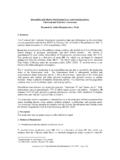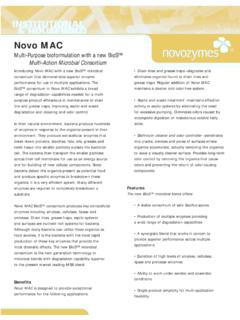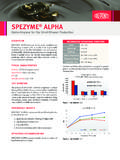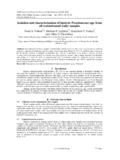Transcription of Enzyme Production - EOLSS
1 BIOTECHNOLOGY - Vol. V - Enzyme Production - Rajni Hatti-Kaul Enzyme Production . Rajni Hatti-Kaul Department of Biotechnology, Center for Chemistry & Chemical Engineering, Lund University, Lund, Sweden Keywords: bulk enzymes, diagnostic enzymes, therapeutic enzymes, Enzyme source, fungi, bacteria, transgenic plants, extremophiles, microbial screening, microbial strain development, catabolite repression, inducer, mutation, recombinant DNA technology, random mutagenesis, site directed mutagenesis, Enzyme stability, protein engineering, submerged fermentation, sterilization, stirred tank reactor, batch fermentation, continuous fermentation, solid state fermentation, downstream processing, solid-liquid separation, filtration, filter aid, flocculation, microfiltration, ultrafiltration, centrifugation, concentration, precipitation, aqueous two-phase systems, adsorption, S.
2 TE S. high resolution purification, chromatography, crystallization, formulation, spray drying, freeze-drying, immobilization R. Contents AP LS. C EO. 1. Introduction 2. Enzyme Source 3. microbial Strain Selection 4. Strain Development E . Mutation and Selection H. Hybridization PL O. Recombinant DNA Technology Engineering the Enzyme M SC. 5. Growth Requirements of Microorganisms 6. Fermentation Submerged Fermentation SA NE. Solid State Fermentation 7. Isolation and Purification of Enzymes Disruption of Cells and Tissues Disruption of microbial Cells U. Homogenisation of Animal/Plant Tissue Clarification of Culture Broths/Homogenates Filtration Centrifugation Pretreatment of Broth to Facilitate Clarification Flotation Concentration and Initial Fractionation Evaporation Ultrafiltration Precipitation Adsorption Integrated Technologies for Downstream Processing Extraction in Aqueous two-phase Systems.
3 Encyclopedia of Life Support Systems ( EOLSS ). BIOTECHNOLOGY - Vol. V - Enzyme Production - Rajni Hatti-Kaul Expanded Bed Adsorption High Resolution Purification by Chromatography Adsorption Chromatography Size-Exclusion Chromatography Crystallization for Enzyme Purification 8. Product Formulation 9. Regulations during Enzyme Production Acknowledgments Glossary Bibliography Biographical Sketch Summary Commercial Enzyme Production has grown during the past century in volume and S. TE S. number of products in response to expanding markets and increasing demand for novel R. AP LS. biocatalysts. Microorganisms constitute the major source of enzymes, but several enzymes are also obtained from renewable animal and plant sources. Traditional Enzyme Production relied on the natural hosts as raw materials, however genetic C EO.
4 Engineering has now given a choice for producing sufficient quantities of enzymes in selected Production hosts including microorganisms and transgenic plants. Production of a new microbial Enzyme starts with screening of microorganisms for desirable activity using appropriate selection procedures. The harsh environment to E . H. which several enzymes are subjected during process applications has given impetus to screening of extremophiles for enzymes having desirable features of activity and PL O. stability (see also Biotechnological Exploration of Extremophiles in the Genomic and M SC. metagenomic era). The level of Enzyme activity produced by an organism from a natural environment is often low and needs to be elevated for industrial Production .
5 Increase in Enzyme levels is often achieved by mutation of the organism. An alternative strategy that has gained favour is Production of the Enzyme in a recombinant organism SA NE. of choice whose growth conditions are well optimized and whose GRAS status is established. Random or site-directed mutagenesis with the purpose of engineering the activity and stability properties of an Enzyme prior to its Production is becoming a U. common practice. The microorganisms used for Enzyme Production are grown in fermenters using an optimized growth medium. Both solid state- and submerged fermentation are applied commercially, however the latter is preferred in many countries because of a better handle on aseptic conditions and process control.
6 The enzymes produced by the microorganism may be intracellular or secreted into the extracellular medium. Isolation and purification, downstream processing of Enzyme from the raw material constitutes the subsequent key stage in the Production process. The desired level of purification depends on the ultimate application of the Enzyme product. The industrial bulk enzymes are relatively crude formulations while speciality enzymes undergo a thorough purification to yield a homogeneous product. A traditional downstream processing scheme involves stages of clarification for separation of the Enzyme from the solids comprising the raw material, concentration to reduce the process volumes, and Encyclopedia of Life Support Systems ( EOLSS ).
7 BIOTECHNOLOGY - Vol. V - Enzyme Production - Rajni Hatti-Kaul purification to separate it from other soluble contaminants. In case of the intracellular enzymes, disruption of cells or tissue for release of the product is among the primary separation steps. There is a choice of different separation techniques for each stage. Chromatography is the major technique for high-resolution purification of enzymes. Some separation techniques allow integration of the downstream processing stages required for purification thus reducing the number of steps and hence the Production costs. The Enzyme is finally formulated as a liquid or solid product. In either case, stabilizing additives are added for rendering long shelf life to the product.
8 Some enzymes are immobilized to solid supports or Enzyme crystals are cross-linked to render them insoluble and stable for repeated or long term use in a process application. Large scale Production of enzymes has to comply with the standards set by International Organization of Standardization for ensuring quality and Production efficiency, and also environmental management control, whenever applicable. 1. Introduction S. TE S. R. AP LS. The Production of enzymes is central to the modern biotechnology industry. The traditional industrial enzymes continue to have expanding markets, and the recognition of potential to use biocatalysis in various industrial sectors for new applications C EO. generates demand for enzymes with novel activities and/or improved stability (see also microbial enzymes for food processing).
9 Man has utilized enzymes throughout the ages either in the form of vegetables rich in enzymes, or as microorganisms used for a variety of purposes, for instance in brewing, baking, and in cheese Production . However, it was only in the 19th century that the various biological conversions were E . H. ascribed to the action of enzymes. This was initiated by the isolation of an Enzyme PL O. complex from malt by Payen and Persoz in 1833, termed diastase' that converts gelatinized starch into sugars, primarily maltose. The history of modern Enzyme M SC. Production really began in 1874 when the Danish chemist Christian Hansen first produced rennet by extracting it from dried calves stomachs with saline solution. Apparently, this was the first Enzyme preparation of relatively high purity used for industrial purposes.
10 During the early part of the last century, in the Far East, an age-old SA NE. tradition involving the use of mould fungi called koji (see also Food fermentation and processing) in the Production of certain foodstuffs and flavour additives based on soya protein and fermented beverages, formed the basis on which the Japanese scientist U. Takamine developed a fermentation process for the industrial Production of fungal amylase . The process included the culture of Aspergillus oryzae on moist rice or wheat bran, and the product was called 'Takadiastase' which is still used as a digestive aid. The value of the industrial enzymes market was estimated to $ 2 billion, and has increased at an average annual rate of 3-5 percent during the past decade.

















